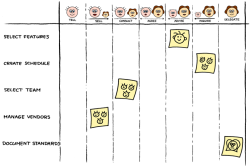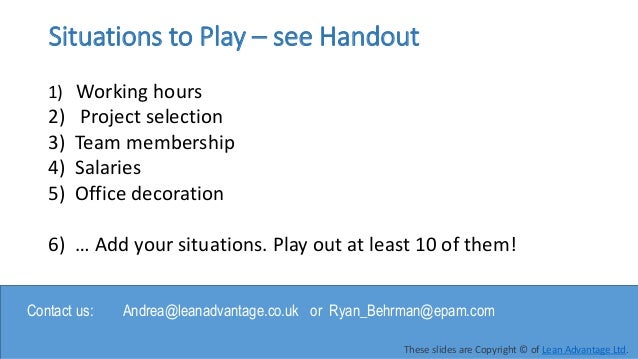Delegation Poker Situations
- Delegation Poker Situations Youtube
- Delegation Poker Situations Chart
- Delegation Poker Situations List
- Tag / delegation poker March 22, 2016 July 24, 2017 by Frederik. Delegation poker & authority boards – Management 3.0. (in case of situations going wrong).
- Use Delegation Poker to clarify who’s responsible for what and to what level. This is a method where you can encourage employee engagement through controlled self-organization and clarified value and decision-making.

How to play Delegation Poker - Duration: 3:30. Troy Daniel Recommended for you. How to Delegate Better with the 7 Delegation Levels - Duration: 4:27. Use Delegation Poker to clarify who’s responsible for what and to what level. This is a method where you can encourage employee engagement through controlled self-organization and clarified value and decision-making. Team members should be organized in groups of three to seven people. Each teammate gets a set of cards numbered 1 through 7, signifying the Seven Levels of Delegation (see below. The Delegation Poker game was first played at the Scrum Gathering in Amsterdam.Since then I had people play it in a number of workshops, and I improved it with their feedback. Here is the first.
Scrum is about team self-management. In order to progressively and clearly share management practices between a manager and his team, we propose to use the Delegation Poker.
The Delegation Poker is a card game that is promoted by Management 3.0 practices. The objective is to foster discussions about different management matters and how they should be handled in the team .
Delegation Poker – The Recipe
- Step 1: Brainstorming and listing on the different topics of “What is Team Management ?”
- Step 2: On each topic, the manager and the team play the delegation poker game with the dedicated cards
- Step 3: After discussion, they assign a score from 1-7 to each topic for further reference
During Step 2, each team member, and the manager, indicate for each topic the value he would choose (everyone presents his card at the same time). The values are the following:
1- Tell – I will tell them
2 – Sell – I will try and sell it to them
3 – Consult – I will consult and then decide
4 – Agree – We will agree together
5 – Advise – I will advise but they decide
6 – Inquire – I will inquire after they decide
7 – Delegation – I will fully delegate
where:
I = manager
we = team
The manager and the team discuss the results, and if needed they play multiple rounds until they agree on a decision.
Why are we doing this again?
This practice helps clarify certain aspects, like for example who decides on the holidays. Is the manager having the final say in this ? Why does he want this ? Is he ready to let this decision to the team ?
The value of this practice often lies in the discussion behind the vote. The discussions raise concerns from both the manager and the team which ultimately help both to better understand each other. This practice also shows where there is room for the team to take more initiative and responsibilities.
Make it visible !
At the end of the delegation poker, the teams creates its delegation board with a summary of all the decisions taken. The format doesn’t matter (paper version on a wall or in a wiki) but the content serve as reference for future management practices.
Lessons Learned
It is important to manage the delegation board as a living tool.
Make sure when doing the delegation poker that the team knows that the decisions aren’t engraved in stone. If circumstances evolve, anyone has the possibility to trigger a new delegation poker to adapt to the new situation.
Many times there is not clarity about some hard decisions that Managers has to rule and many times there are some decisions that should be delegated (of course after gaining the truth).
If you have to coach managers one of the suggestions is to delegate any decisions in order to get more time to dedicate to coach their employees.
I found this amazing exercise called “Delegation Poker” in Management 3.0 written by Jurgen Appelo.
The following statement were extracted from Management 3.0
“Delegation often comes down to either “I do it” or “You do it.” But there are really Seven Levels of Delegation. Use Delegation Poker to make clear who’s responsible for what and to what level. This is a method where you can encourage employee engagement through controlled self-organization and clarified value and decision-making.
How do we play Delegation Poker?
Each team plays this game differently, so you can follow some of the more common rules we’re sharing here or you can make up your own. It’s all about organizing how you and your team look at delegation and self-organization.
Start by making a list of pre-defined cases or situations in which you want to create a delegation policy, establishing who has what influence. This can range from project design and authority to hiring new team members.

Team members should be organized in groups of three to seven people. Each teammate gets a set of cards numbered 1 through 7, signifying the Seven Levels of Delegation (see below.)
Team members will repeat the following steps for each pre-defined case:
Delegation Poker Situations Youtube
- One person picks out a situation to read aloud OR he tells a story from personal experience.
- Each player chooses one of the seven delegation cards privately, reflecting on how she would delegate the decision in that particular situation.
- When all players have decided, they reveal their selected cards.
- Everyone earns points according to the value of their selected card, except the players that are the “highest minority” (see below).
- Let the people with the highest and the lowest cards explain the reasoning behind their choices.
- You can then create a Delegation Board to show the results of your consensus.”
Delegation Poker Situations Chart
I used this exercise with a Product Owner, and stakeholder and a couple of Scrum Masters in order to decide many decisions such as: “Interaction between Stakeholders and Scrum team members”. I know you should think: easy. Stakeholders only have to communicate with team members through Product Owner but I ran into missing Product Owners so it is good to know what is the boundary of this way of communication.
Delegation Poker Situations List
To sum it up, this exercise is a great tool to change the behaviour of command and control. Every manager should delegate tasks time to time to get more time to do more important tasks.